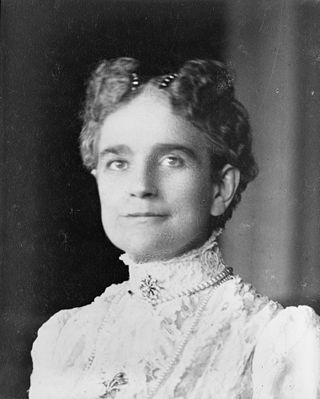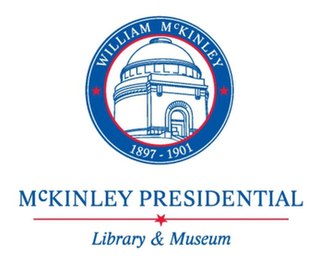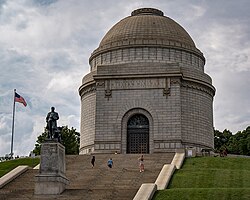Designs, construction
Over sixty designs were submitted, and Harold Van Buren Magonigle of New York City was selected as the winner of the competition. Magonigle envisioned a cross-hilted sword with a mausoleum located at the junction of the blade, guard, and hilt. The Long Water (a five-tiered reflecting pool which was 575 feet long) and main steps would form the handle of the sword. This design combined the cross of a martyr with the sword of a President who had acted as commander-in-chief during wartime.
Construction of the memorial began on June 6, 1905, when Magonigle removed the first shovel of soil from the site. By November 16 the cornerstone was laid in an official ceremony attended by the former First Lady, Ida Saxton McKinley, and other family members. More than 35,000 cubic yards (27,000 m³) of soil were added to create four terraces coinciding in height and pitch with the four runs of steps in the main staircase. The steps are 50 feet (15 m) wide and arranged in four flights of 24. Another 12 steps take visitors into the monument. In total, there are 108 steps from ground level to the top of the monument. The interior walls consist of Tennessee marble. [2]
The 9-1/2 foot tall bronze statue depicting President McKinley delivering his final public address at Buffalo, New York, on September 5, 1901 was created by sculptor Charles Henry Niehaus. It is based on a photograph of the President taken by White House photographer Frances B. Johnston at the Pan-American Exposition the day before his assassination.

William McKinley was the 25th president of the United States, serving from 1897 until his assassination in 1901. A member of the Republican Party, he led a realignment that made Republicans largely dominant in the industrial states and nationwide for decades. He presided over victory in the Spanish–American War of 1898; gained control of Hawaii, Puerto Rico, Guam, and the Philippines; restored prosperity after a deep depression; rejected the inflationary monetary policy of free silver, keeping the nation on the gold standard; and raised protective tariffs.

Canton is a city in and the county seat of Stark County, Ohio, United States. It is located approximately 60 miles (97 km) south of Cleveland and 20 miles (32 km) south of Akron in Northeast Ohio on the edge of Ohio's Amish Country. As of the 2020 census, the population of Canton was 70,872, making Canton eighth among Ohio cities in population. It is the largest municipality in the Canton–Massillon metropolitan area, which includes all of Stark and Carroll counties, and was home to 401,574 residents in 2020.

Ida McKinley was the first lady of the United States from 1897 until 1901, as the wife of President William McKinley. McKinley also served as the First Lady of Ohio from 1892 to 1896 while her husband was Governor of Ohio.

Ralph Straus Regula was an American politician from Ohio. A member of the Republican Party, he served in the Ohio House of Representatives, the Ohio State Senate and the United States House of Representatives. He represented Ohio's 16th congressional district for 18 terms from 1973 to 2009. In the 110th Congress (2007–2009), he was the second longest serving Republican member of the House of Representatives.

William Rufus Day was an American diplomat and jurist who served as an associate justice of the Supreme Court of the United States from 1903 to 1922. Prior to his service on the Supreme Court, Day served as United States Secretary of State during the administration of President William McKinley. He also served as a United States circuit judge of the United States Court of Appeals for the Sixth Circuit and the United States Circuit Courts for the Sixth Circuit.

The McKinley Monument is a 96-foot (29 m) tall obelisk in Niagara Square, Buffalo, New York. Its location in front of Buffalo City Hall defines the center of Buffalo that all of the main roads converge on.

Charles Henry Niehaus was an American sculptor.

Theodore Roosevelt Inaugural National Historic Site preserves the Ansley Wilcox House, at 641 Delaware Avenue in Buffalo, New York. Here, after the assassination of William McKinley, Theodore Roosevelt took the oath of office as President of the United States on September 14, 1901. A New York historical marker outside the house indicates that it was the site of Theodore Roosevelt's Inauguration.

The Statue of William McKinley is a 8.5-foot (2.6 m) bronze statue of President of the United States William McKinley. The statue, sculpted by Haig Patigian, stood in the center of the town plaza in Arcata, California, from 1906 to 2019, when it was moved to Canton, Ohio.

First Ladies National Historic Site is a United States National Historic Site located in Canton, Ohio. During her residency in Washington, D.C. Mary Regula, wife of Ohio representative Ralph Regula, spoke regularly about the nation's first ladies. Recognizing the paucity of research materials available she created a board to raise funds and for a historian to assemble a comprehensive bibliography on American first ladies. From these inspirations came a National First Ladies’ Library, established in 1996, and the First Ladies National Historic Site.

McKinley at Home, Canton, Ohio aka William McKinley at Canton, Ohio is a silent film reenactment of William McKinley receiving the Republican nomination for President of the United States in September 1896. The actual nomination had been several weeks earlier. McKinley is shown emerging from his house to receive the news from his secretary George Cortelyou. His wife Ida can be seen in a rocking chair on the porch. McKinley is seen removing his hat and wiping his forehead with a handkerchief after receiving the news. It was filmed by a two-man crew for American Mutoscope and Biograph Company on 68 mm film, 60.02 m in length. McKinley's brother Abner and former US president Benjamin Harrison were stockholders in the film company.

William McKinley, the 25th president of the United States, was shot on the grounds of the Pan-American Exposition in the Temple of Music in Buffalo, New York, on September 6, 1901, six months into his second term. He was shaking hands with the public when an anarchist, Leon Czolgosz, shot him twice in the abdomen. McKinley died on September 14 of gangrene caused by the wounds. He was the third American president to be assassinated, following Abraham Lincoln in 1865 and James A. Garfield in 1881.

The presidency of William McKinley began on March 4, 1897, when William McKinley was inaugurated and ended September 14, 1901, upon his assassination. A longtime Republican, McKinley is best known for conducting the successful Spanish–American War (1898), freeing Cuba from Spain; taking ownership of the Republic of Hawaii; and purchasing the Philippines, Guam and Puerto Rico. It includes the 1897 Dingley Tariff which raised rates to protect manufacturers and factory workers from foreign competition, and the Gold Standard Act of 1900 that rejected free silver inflationary proposals. Rapid economic growth and a decline in labor conflict marked the presidency and he was easily reelected. He was succeeded by Vice President Theodore Roosevelt following his death.

The National McKinley Birthplace Memorial Library and Museum is a national memorial to President William McKinley, located in Niles, Ohio. Also known as the McKinley Memorial Library, Museum & Birthplace Home, the memorial is a 232 by 136 by 38 ft marble monument with two wings. One wing houses the public McKinley Memorial Library, and the other features the McKinley Museum with exhibits about President McKinley and an auditorium.

Major General John A. Logan, also known as the General John A. Logan Monument and Logan Circle Monument, is an equestrian statue in Washington, D.C., that honors politician and Civil War general John A. Logan. The monument is sited in the center of Logan Circle, a traffic circle and public park in the Logan Circle neighborhood. The statue was sculpted by artist Franklin Simmons, whose other prominent works include the Peace Monument and statues in the National Statuary Hall Collection. The architect of the statue base was Richard Morris Hunt, designer of prominent buildings including the Metropolitan Museum of Art in New York City and The Breakers in Newport, Rhode Island. Prominent attendees at the dedication ceremony in 1901 included President William McKinley, members of his cabinet, Senator Chauncey Depew, Senator Shelby Moore Cullom, and General Grenville M. Dodge.

Crossroads United Methodist Church is a historic Methodist church in Canton, Ohio. Originally the First Methodist Episcopal Church, it was renamed Church of the Savior United Methodist in 1968. Then in 2014, after its congregation was merged with Saint Paul's United Methodist Church, it was renamed Crossroads United Methodist Church. It was built in 1881 in a High Victorian Gothic style. The building was added to the National Register of Historic Places in 1979.

The William McKinley Presidential Library and Museum is the presidential library of 25th U.S. president William McKinley. The library, which is located at the foot of the McKinley National Memorial, is owned and operated by the Stark County Historical Society, and located in Canton, Ohio, where McKinley built his career as lawyer, prosecuting attorney, congressman, governor and president.

The McKinley Birthplace Memorial gold dollar was a commemorative coin struck by the United States Bureau of the Mint in 1916 and 1917, depicting the 25th President of the United States, William McKinley. The coin's obverse was designed by Charles E. Barber, Chief Engraver of the Mint, and the reverse by his assistant, George T. Morgan. As McKinley had appeared on a version of the 1903-dated Louisiana Purchase Exposition dollar, the 1916 release made him the first person to appear on two issues of U.S. coins.

The William McKinley Monument, or McKinley Memorial, is a statue and memorial honoring the assassinated United States President William McKinley which stands on Capitol Square to the west of main entrance of the Ohio Statehouse in Downtown Columbus, Ohio.

The William McKinley Memorial is a statue honoring the assassinated United States President William McKinley. It stands at the foot of Panhandle Park, San Francisco, California, and faces the DMV across Baker Street. Created by Robert Ingersoll Aitken (1878–1949) in 1904, the Monument was dedicated in 1903 by President Theodore Roosevelt, who succeeded McKinley after his assassination in 1901. The monument was unveiled on November 24, 1904 at the entrance to the Golden Gate Park panhandle. Over 5,000 people came to the unveiling. Speeches were made by former Mayor James D. Phelan, Mayor Eugene Schmitz, John McNaught, and others.

























